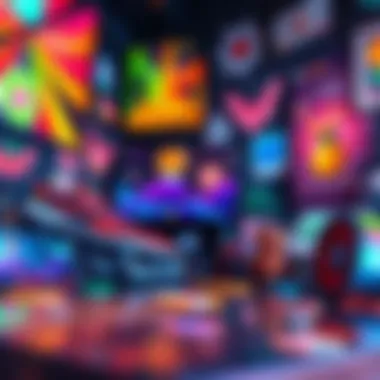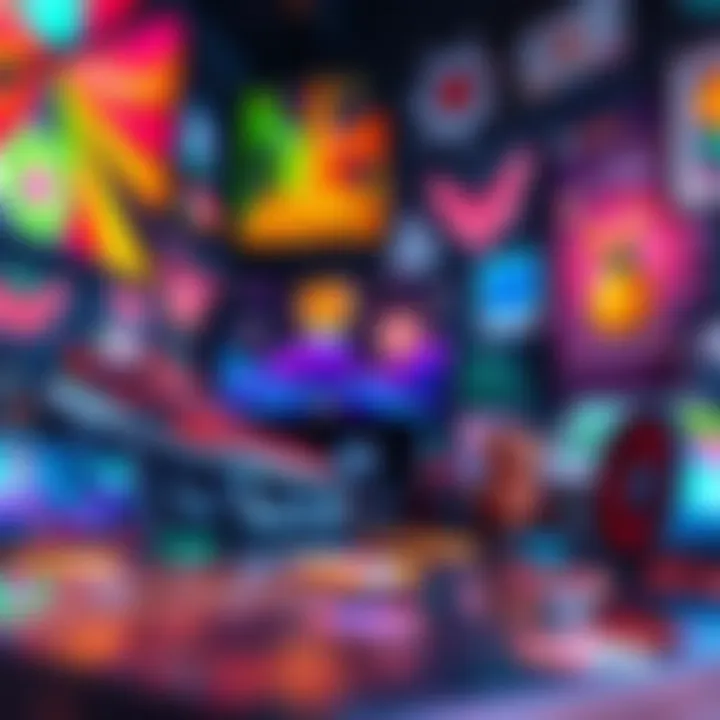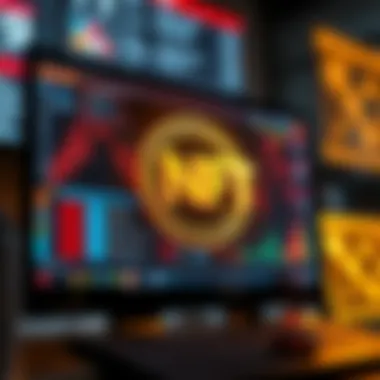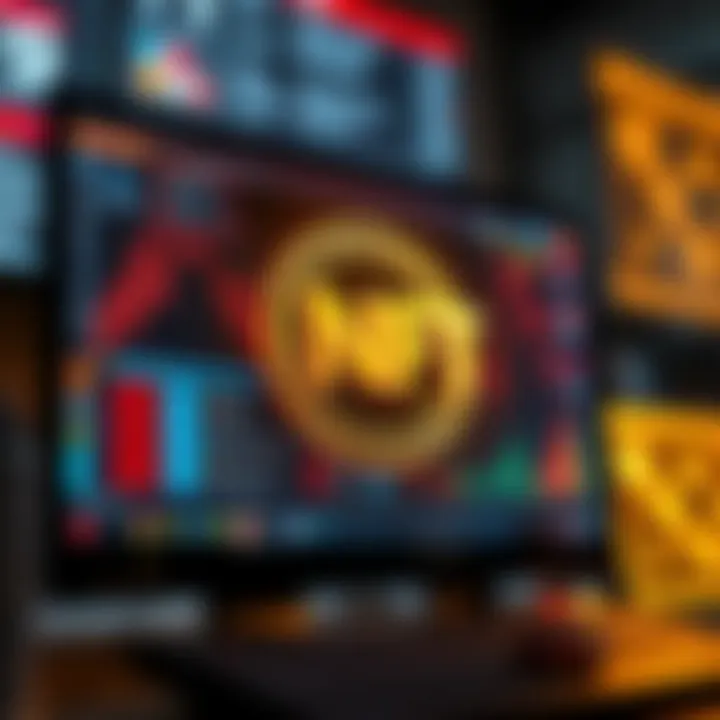Creating NFT Art: Your Complete Guide to Success


Intro
In recent years, the art world has seen an explosive rise in digital assets, notably NFTs, or non-fungible tokens. These one-of-a-kind digital certificates have transformed how artists create, share, and monetize their work. While the term NFT might sound high-tech or even intimidating at first, the process of creating NFT art can be broken down into manageable steps that any artist can follow. From understanding the underlying technology to effectively promoting your creations, this guide aims to demystify the journey into the realm of NFT art.
The fusion of creativity with blockchain technology seems to have opened more doors than just the mere act of creating digital art; it represents a movement towards ownership and authenticity in the digital space. Many artists are jumping on the bandwagon, not just to embrace new trends but also to explore the potential for substantial earnings. However, before diving headfirst into the vibrant yet complex world of NFTs, it’s essential to grasp some of the fundamentals that govern this arena.
By the end of this guide, you should have a well-rounded understanding of how to create NFT art, from the inception of your creative process to minting your work and market strategies to ensure your pieces gain traction in a crowded marketplace.
Understanding NFTs
In the dynamic realm of art and digital assets, grasping the concept of Non-Fungible Tokens, commonly known as NFTs, is crucial for artists and collectors alike. NFTs are not just buzzwords; they are pivotal tools that shape how we view and interact with digital ownership. At their core, NFTs breathe new life into the art world, enabling artists to monetize their creations in ways that traditional mediums couldn't fathom. More than just unique assets, they foster a deeper connection between creators and their audience, creating an ecosystem vibrant with possibilities.
Definition of NFTs
NFTs are digital tokens representing ownership of a unique item or piece of content stored on a blockchain. Unlike cryptocurrencies like Bitcoin or Ethereum, which are interchangeable or fungible, each NFT contains distinct information. This uniqueness is what sets NFTs apart, making them ideal for artists looking to sell their digital works, whether that be images, animations, or even music.
The Technology Behind NFTs
Blockchain fundamentals
Blockchain technology serves as the backbone of NFTs, ensuring transparency and security in ownership. Essentially, a blockchain is a decentralized ledger that records transactions across multiple computers. This means that no single entity can claim control over the data, making it difficult to alter or erase. For artists, this provides a level of assurance that their work is protected. Moreover, the immutability of blockchain allows buyers to trace the provenance of an artwork, adding value to the ownership experience.
Smart contracts explained
Smart contracts play an integral role in the NFT landscape. These are self-executing contracts with the terms of the agreement directly written into code. Such contracts facilitate transactions without the need for intermediaries, streamlining the process of buying and selling NFTs. With smart contracts, artists can also program royalties into their NFTs, enabling them to earn a percentage of sales every time their work is resold—an innovative feature that aligns the interests of creators and collectors alike.
Types of NFTs
As NFT technology has evolved, so too have the various types of NFTs available in the marketplace. The distinct categories each bring their own unique attributes and appeal:
Artistic NFTs
Artistic NFTs represent digital art pieces, providing artists a platform to showcase and sell their work in the digital sphere. The unique characteristic of this category lies in its ability to transform traditional art concepts into innovative digital expressions. They not only elevate artists' visibility but also provide collectors a chance to own original works in a way that's verifiable on the blockchain. While some may argue that the digital nature diminishes the value of art, others believe it opens doors to a new level of creativity and engagement.
Music and audio
Music NFTs pave the way for musicians to gain control over their work in the digital domain. Artists can sell exclusive tracks or entire albums as NFTs, allowing fans to own a piece of musical history. This method of distribution can often lead to more revenue than traditional sales methods, as artists can bypass intermediaries like record labels. However, the challenge lies in educating fans about the value of owning an NFT over a mere download.
Collectibles and gaming assets
In the world of collectibles and gaming assets, NFTs have begun to redefine ownership. These can range from virtual trading cards to in-game items that users can buy, sell, or trade as NFTs. The defining aspect of this category is the community engagement it fosters. Gamers can own unique characters or items, which can appreciate in value over time. However, the fast-paced nature of the gaming industry means that only the most popular assets maintain relevance, making it a risky endeavor for investors.
In summary, understanding NFTs involves delving into their definition, the underlying technology, and the different types that exist. Artistry, music, and collectibles are just the beginning, as the potential applications for NFTs continue to grow. By familiarizing oneself with these elements, artists and investors can better navigate the complexities of this digital domain.
The Artistic Process
The artistic process is at the heart of creating NFT art. This phase shapes the physical form of an artist's unique expression and lays the groundwork for all subsequent steps. Diving into this process involves multiple stages: choosing the right medium, generating powerful concepts, developing your artwork, and ensuring that the final piece shines before minting it as an NFT. There are numerous brushes to use, and the palette of considerations is extensive.
Choosing Your Medium
Choosing your medium is a foundational step in the artistic process, as it heavily influences the trajectory of your artwork. From digital illustrations to photography, each medium offers distinct advantages.
Digital illustration
Digital illustration shines brightly in the current NFT landscape. The beauty of digital art lies in its versatility. Artists can create pieces that can transform and evolve, unlike traditional mediums. Yoou can easily adjust colors, layers, and shapes without starting from scratch. This flexibility is a significant reason why many artists today gravitate toward digital illustration.
A key feature of digital illustration is its integration with various tools and platforms. Programs like Adobe Illustrator or Procreate allow for nuanced designs that contribute beautifully to the NFT space. However, digital art might face critiques regarding perceived value, as some enthusiasts argue it lacks the „tangible“ essence found in physical artworks.
Photography and video
Photography and video are captivating mediums in the realm of NFTs. The immediacy and realism of captured images can evoke powerful emotions. It’s a powerful way to tell stories that resonate with viewers. With platforms like Instagram or specialized NFT spaces, photographers and videographers can showcase their work to a larger audience.
A unique feature here is the ability to create visuals that offer more than static art; they can provide a moving experience. However, one might face the challenges of exclusivity and originality. With so much content available, standing out can be an uphill battle.
3D modeling


3D modeling is emerging as a compelling medium for NFTs. This method allows artists to create interactive and immersive experiences that can redefine art's boundaries. The ability to manipulate space and dimension is a thrilling aspect for many creators. With tools like Blender or Zbrush, it opens endless possibilities for creativity and engagement.
Yet, 3D modeling carries its own set of challenges, mainly in terms of complexity and technical skill required. It requires a different set of expertise and tools, which can be a barrier for some artists. However, when done well, it creates captivating pieces that can draw significant attention.
Creating Your Artwork
Creating your artwork is about transforming ideas into striking pieces that represent your insights and vision. This phase encompasses concept development, choosing the right design tools, and refining your ideas.
Concept development
Concept development is the backbone of any artistic endeavor. At this stage, the artist hones in on an idea, exploring its emotional depth and significance. A well-thought-out concept imparts meaning and connects the artwork to its audience. Here, creativity meets intentionality, resulting in pieces that resonate.
A standout feature of concept development is the process of brainstorming and sketching initial ideas. This stage allows the artist to experiment freely without pressure. However, the struggle might arise when constantly revisiting and evolving ideas, sometimes leading to creative blocks.
Design tools and software
Design tools and software have transformed how artists create in the digital age. Options abound, ranging from user-friendly programs to sophisticated software for advanced users. These tools enable artists to implement their ideas deftly and with precision.
Tools like Adobe Photoshop and Corel Painter bring forth myriad brushes and effects, allowing for unique artistic expressions. The incorporation of software can streamline the creative process, making it faster and often more enjoyable. Yet, one must balance technology with traditional artistic skills to maintain a sense of authenticity and craft.
Iterating on your ideas
Iterating on your ideas refers to the ongoing process of revising and enhancing your artwork. Artists return to their work, often multiple times, refining and adjusting until they believe it truly represents their vision. This is a vital part of ensuring quality and relevance, whether addressing aesthetic or emotional elements.
Unique about iteration is how it embraces imperfection. It’s a part of the creative journey. However, this process can be both tedious and frustrating; knowing when to stop refining is a challenge many artists face.
Finalizing Your Art for NFT Minting
Finalizing your art before minting is a crucial step that many artists overlook. This phase involves getting technical specifications in order and ensuring your artwork meets standards, along with addressing distinct considerations.
File formats and resolutions
Understanding file formats and resolutions can make or break your NFT experience. Different platforms have variant requirements, and navigating this landscape is critical for your artwork's success. Common file formats include PNG, GIF, and MP4, each offering specific benefits depending on your artwork type. A nuanced approach can ensure that your creation retains its quality in various viewing environments.
The unique feature of file formats is how they affect visual clarity. An improper format can lead to pixelation, destroying the viewer's experience. On the other hand, overcomplicating formats can lead to unnecessary storage use and might even hinder the minting process.
Metadata considerations
Metadata plays a hidden yet significant role in minting NFTs. It’s essentially the information attached to your artwork, offering context and value to potential buyers. Good metadata can improve visibility and enhance discoverability on marketplaces. This can cover everything from title and description to artist credentials.
The unique feature of metadata is its longevity; once established, it remains with your NFT, influencing resale value. However, caring too much about metadata can lead to an overwhelming focus on technical aspects rather than the art itself.
Ensuring originality
Ensuring originality is non-negotiable in NFT creation. Intellectual property rights are central to this realm, but verifying the uniqueness of your artwork solidifies your reputation. Claiming originality gives your art authenticity and can significantly affect its market viability. It’s imperative to showcase your distinct voice.
What’s unique here is the impact of originality on community engagement. Buyers want to feel they own something rare. However, the pressure to create groundbreaking work can lead to artists second-guessing their capabilities.
"An artist's uniqueness is their greatest asset in the NFT landscape. Stand out – and the market will reward you."
The artistic process is filled with layers that contribute to the creation of NFTs. A nuanced understanding of media choice, concept development, and finalization techniques ultimately creates works that can resonate with a broad audience. It's an intricate dance between technology and creativity, but mastering this craft begins with consistently refining your approach.
Minting Your NFT
The term "minting" in the NFT realm refers to the process of turning your digital art into a unique token on the blockchain. This process is crucial because it preserves your work's authenticity, establishes its ownership, and enables you to sell it on various marketplaces. Minting transforms the digital file you’ve created into something that holds value and can be traded, similar to traditional art. Without this step, your hard work remains just another file on your computer, unable to capture the interest of collectors and investors looking for one-of-a-kind assets.
Choosing the Right Marketplace
Marketplaces act as a bridge between creators and buyers, giving your NFTs visibility in a crowded digital space. With so many options, choosing the right one heavily influences your success.
Popular NFT platforms
When it comes to popular NFT platforms like OpenSea, Rarible, and SuperRare, they stand out for their extensive user bases and diverse art offerings. For instance, OpenSea is often seen as the largest marketplace, making it a go-to choice for many artists simply due to the sheer potential audience. Artists can showcase their work to thousands of potential buyers, driving up the chances of a sale.
However, each platform comes with its own unique features. Take Rarible, for example. It's community-driven, allowing users to govern its future through RARI tokens. This enables artists and collectors to have a role in platform evolution, which can be particularly appealing to those seeking a feeling of involvement beyond mere transactions. But don’t get too carried away; it’s essential to assess the platform's culture and community, as it directly affects how your art is perceived.


Marketplace fees and requirements
Marketplace fees can make or break a new artist. For instance, platforms often charge listing or transaction fees, which could take a significant bite out of your profits if you're not careful. Understanding fee structures before committing to a platform is crucial. For example, while OpenSea might have lower fees, SuperRare might offer more premium visibility at a higher cost.
When you consider these charges, it's wise to factor them into your pricing strategy. It can be shocking to see how quickly fees accumulate, especially on multiple transactions. Sometimes, they can approach 15% of your sale or even more, cutting into earnings drastically. Knowing the requirements to list your NFT—like ensuring your wallet is compatible—will save you time and headaches down the line.
Setting Up a Digital Wallet
Before minting, you’ll need a digital wallet to store your NFTs and any cryptocurrencies. It’s an essential step and ensures that you have a safe place for your assets.
Wallet types overview
There are several wallet types, including hot wallets and cold storage solutions. Hot wallets, like MetaMask, offer convenience and quick access, making them ideal for everyday transactions. These are often user-friendly and allow for immediate use with various marketplaces.
On the other hand, cold wallets like Ledger Nano are much safer, keeping assets offline and away from potential hacks. However, the trade-off is convenience; accessing funds takes extra steps, which might not suit those eager to engage quickly in the NFT marketplace.
Weighing the pros and cons of each option will empower you to make an informed decision on what best fits your needs and comfort level with technology.
Connecting your wallet to the marketplace
Once you've set up your digital wallet, connecting it to your chosen marketplace is the next logical step. This typically involves a straightforward process where you log in to the marketplace and link your wallet. Keeping security in mind is paramount during this step; ensuring you’re using a secure internet connection reduces potential risks.
A unique feature of this connection is that it allows for direct transactions and sales without needing to transfer funds back and forth, streamlining the selling process. It can be a tad confusing initially, but once you’re connected, you can easily handle sales and purchases.
The Minting Process
Minting your NFT is truly where the magic happens. You take your artwork and create a token that lives on the blockchain, forever linked to your name as the artist.
Uploading your artwork
The first step in minting is uploading your artwork. This can usually be done with a simple drag-and-drop feature on your chosen platform. You might find that some places offer previews or visual tools to help ensure that your artwork displays well.
It's also vital to choose the correct file format; JPEG and PNG are typically accepted, but some platforms may allow GIFs or videos. Ensuring your file meets the platform’s requirements avoids disappointment later. The ease of image uploads makes the process quite user-friendly, but errors can often lead to frustration, especially if the file is too large or in an unsupported format.
Inputting metadata and attributes
Once your artwork is uploaded, the next key step is adding metadata and attributes. This includes vital information such as the title, description, and potential royalties for future resales. This part is critical because good metadata will help potential buyers understand what they're purchasing and can add value over time.
Notably, some platforms allow you to encode special characteristics or traits into your NFTs, especially valuable within gaming or collectible scenarios. It’s a chance to showcase what makes your art special, which can draw more attention.
Fees and transaction confirmations
Finally, you will need to deal with fees and transaction confirmations. Each transaction generally incurs a gas fee, which is the cost of processing on the blockchain. This can fluctuate wildly, often depending on network congestion, so keeping an eye on fee trends is wise.
Additionally, after minting, you may have to wait for confirmations before your NFT appears on the marketplace. This could take anywhere from a few minutes to longer, depending on the platform and network load. Understanding these aspects will prepare you well for the minting experience and can shape your launch strategy effectively.
“Minting an NFT isn't just a checkbox exercise; it’s the gateway to transforming your creativity into tangible value.”
Each of these components—selecting a marketplace, setting up wallets, and understanding the minting process—carries its significance. Ensuring you grasp these elements can set you up for success in the digital art landscape.
Marketing Your NFT Art
In the ever-evolving world of NFTs, marketing your digital creations goes beyond just creating beautiful artwork. It stands as a pivotal element in building your presence and carving out a niche for your work in an overcrowded marketplace. This part of the guide delves into the strategies that can turn your NFT art into a recognized brand. A well-structured marketing plan not only amplifies visibility but plays a key role in fostering community engagement and driving sales.
Building an Online Presence
Social media strategies
When it comes to expanding your reach, social media platforms like Twitter, Instagram, and TikTok serve as essential tools. These channels allow creators to showcase their work visually and interact with a global audience. A noteworthy aspect of social media strategies is the ability to create engaging content that resonates with potential buyers. This could be behind-the-scenes looks at your artistic process, live streams of your work, or interactive Q&A sessions.
The key characteristic here is the immediacy of engagement. Social media fosters real-time connections, giving artists the chance to gather feedback and build relationships with followers. This is particularly beneficial for artists new to the scene, as it provides a platform to test the waters and gauge market reception. However, while social media can yield significant rewards, inconsistency in posting or a lack of genuine interaction can lead to disengagement.
Creating a portfolio website
Having a dedicated portfolio website gives you a professional edge. It serves as a hub where potential buyers can explore your body of work in depth. This platform gives you control over how you present your art, offering the chance to tell your story, describe your creative process, and include detailed information about each piece.


A standout feature of having a portfolio website is the ability to showcase diverse artworks all in one place, rather than being scattered across social media. This aids in expressing a cohesive artistic vision. However, maintaining a website requires regular updates and a commitment to keeping the content fresh. Without this, your site can quickly become stale, potentially driving visitors away.
Engaging with the Community
Leveraging online forums
Online forums such as Reddit or specialized art communities are invaluable for networking and sharing your art. These platforms allow you to tap into niche audiences who are passionate about the same topics as you. A significant aspect of leveraging online forums is their informal nature; discussions often feel more personal and can lead to genuine connections. This helps not only in gaining feedback but also in finding potential collaborators or buyers.
The unique feature of online forums is the capability for meaningful dialogue. Engaging actively can help in establishing a reputation within the community. However, one downside is that too much self-promotion can backfire, leading to the community perceiving you as insincere or even spamming. Balance is essential here.
Participating in NFT events and exhibitions
Participating in NFT events and exhibitions, both virtual and physical, gives artists a chance to showcase their work to a targeted audience. These events often bring together creators, collectors, and enthusiasts, making it a ripe environment for networking. The personal interaction can be much more impactful than digital communication, allowing you to create deeper relationships.
A key characteristic of these events is the opportunity for instant feedback and exposure. Engaging directly with enthusiasts can lead to important connections, from like-minded artists to potential buyers. However, while participation may offer benefits, logistical challenges and costs can be considerable, requiring careful planning and resource allocation.
Promotional Strategies
Collaborations with other creators
Collaborating with fellow creators can open new doors for both parties involved. When artists join forces, they not only combine their audiences, but also blend their styles and expertise, often leading to innovative outcomes. This strategy is especially effective in creating buzz around new releases or special projects.
The unique feature of collaborations is the cross-pollination of ideas. By merging concepts, artists can create something that appeals to broader demographics. However, it's important to choose collaborators wisely; mismatched partnerships could dilute your personal brand, leading to confusion among your audience.
Utilizing paid advertisements
Paid ads can be a powerful method for gaining traction in the crowded NFT market. By targeting specific demographics, artists can reach a wider audience that is more likely to be interested in their work. Platforms such as Facebook and Google Ads allow for tailored campaigns that focus on interests and behaviors.
The main advantage of paid advertisements is the rapid increase in visibility. By crafting eye-catching creatives, artists can attract potential buyers effectively. On the flip side, the costs associated with paid advertising can add up, and if not executed carefully, the return on investment might not justify the spend.
Influencer marketing
Teaming up with influencers can also be a significant promotional strategy. Influencers already have an audience that trusts their opinions, making it easier for them to introduce your art to potential buyers. The power of influencer marketing lies in its ability to create credibility and urgency around your work.
The unique aspect of this strategy is the personal touch influencers provide; their followers often see their recommendations as genuine, leading to more meaningful engagement. However, choosing the right influencer is crucial, as the wrong fit could lead to misalignment with your brand image and confuse your audience.
Marketing your NFT art is not just about visibility; it’s about creating genuine connections and building lasting relationships that thrive in the digital space.
Understanding NFT Valuation
Understanding the value of NFT art is critical for both artists and investors in the digital asset landscape. Unlike traditional art, which often derives its worth from historical significance, emotional connection, or unique craftsmanship, NFT valuation is shaped by a host of different factors, from rarity to market trends. This section delves into those elements, clarifying why grasping NFT valuation is not merely academic but pivotal for success in this rapidly evolving market.
Factors Influencing Value
Rarity and uniqueness
Rarity and uniqueness stand at the forefront of NFT valuation. In a world where digital copies are infinite, what makes a piece stand out is its limited availability. Think of it this way: if everyone can have a copy, why would anyone pay a premium? Rarity is often enhanced by exclusivity in design or limited editions released by artists. This concept attracts collectors eager to own a piece of something that is not just desirable but also not widely available.
The unique feature of rarity is its ability to drive demand; a scarce commodity often sees an uptick in value when buyers realize they might miss out. However, one must tread lightly, as overhype could lead to market bubbles.
Artist reputation
The stature of an artist in the digital art scene plays a significant role in determining the value of an NFT. Established artists tend to command higher prices due to their credibility and past work, creating trust among buyers. A key characteristic of artist reputation is its duality: newer artists might struggle, but their works can skyrocket in value if they make a name for themselves. The unique feature here is that an artist's personal brand often becomes part of the artwork's identity, enhancing its appeal. Yet, betting solely on reputation may be risky; art markets can be fickle, and today's star may not shine tomorrow.
Market trends and demand
Market trends serve as a barometer for assessing NFT value. Prices can fluctuate wildly based on buyer interest and broader economic conditions. Recognizing patterns, such as spikes in demand for specific themes or artistic styles, can be beneficial for artists in tailoring their works and pricing. A key characteristic of market trends lies in their volatility—what’s hot one day may be dismissed the next. Therefore, artists need to stay informed by monitoring platforms, social media, and forums to gauge sentiment. The unique advantage is that adept intuition about these trends can lead to a timely and profitable entry into the market, but misreading the signals can spell disaster for any investment.
Post-sale Considerations
After the sale of an NFT, the conversation doesn’t just end. There are several need-to-know aspects that can impact future ventures for both artists and collectors alike.
Royalties on secondary sales
Royalties on secondary sales are one of the most alluring features of NFT transactions. They allow creators to earn a percentage every time their work is sold after the initial purchase. This characteristic creates a sustainable revenue stream that can keep flowing as the work changes hands. A unique aspect of this feature is that it empowers artists to share in the ongoing appreciation of their work, contrasting sharply with traditional art markets where the original artist sees no benefit after the first sale. Nevertheless, not all platforms have uniform policies regarding royalties, making it essential for artists to choose wisely where to mint their NFTs.
Maintaining community engagement
Community engagement post-sale can be as crucial as the artwork itself. Artists who foster a loyal following often find themselves in a favorable position when launching new works or entering collaborations. A key characteristic of maintaining engagement is that it can increase an artist's marketability while creating a sense of belonging for collectors. Joining forums, social media groups, or even engaging with fans through live events allows artists to maintain a connection with their audience. However, the challenge lies in sustaining this engagement without coming off as insincere or overly promotional—a delicate balance that requires genuine effort and creativity.
Building community is not just about selling; it's about creating a shared experience that resonates with people.
Understanding these aspects greatly benefits both artists and investors, ensuring they can navigate the complex landscape of NFT valuation smartly and effectively.















